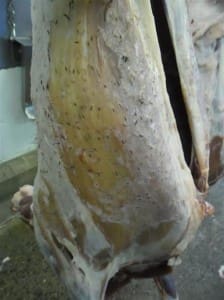SHEEP producers have been urged to start planning their weed and pasture management strategies now in preparation for next spring’s grass seed danger period.
Senior technical officer at Charles Sturt University at Wagga Wagga Dr John Broster said producers need to be thinking about what weed control measures they will use over the growing season that will reduce grass seeds next spring and summer.
“While the short-term goal may be ensuring there are no grass seeds to contaminate their sheep next spring, the longer term goal should be reducing the weed seed bank on their property.”
Dr Broster specialises in herbicide resistance and is involved in Integrated Weed Management projects with the Graham Centre for Agricultural Innovation at CSU.
“Controlling grasses prior to seed set in late spring and early summer will reduce the number of plants that actually germinate in the next autumn.
“Proper control of the plants that do germinate will then reduce the number of plants that set seed, and eventually they should be able to run down their problem,” he said.
“When it comes to controlling grass seeds you have to think well ahead and it may be a one to two year project.”
Grass seeds can lead to processor discounts of up to $1.50/kg for seedy carcases; reduced productivity and welfare of sheep affected by seeds in their bodies and eyes, and; reduced pasture productivity due to weed incursions.
What constitutes “proper control” depends on location, seasonal conditions, existing seedbank composition, the time of year and farming system. Control measures are also determined by the outcome the producer is trying to achieve which may range from a few clean paddocks for lambs and weaners to graze, through to whole-farm weed seed control.
There are a number of useful resources to help producers manage specific grass seeds problems including theWinning Against Seeds manual, Tips and tools: Winning against seeds, MLA webpage: Seed contamination of carcases and the GRDC Integrated Weed Management Hub.
Strategies for managing grass seeds
Spray grazing – Producers can spray graze in autumn and winter when establishing new perennial pastures. Spray grazing uses sub-lethal rates of selective herbicide to increase the palatability of broadleaf weeds, including corkscrew, which are later grazed at high stocking rates.
Winter cleaning – Herbicides such as Simazine will control silvergrass and suppress barley grass and brome grass in pastures, while products such as Sprayseed®, Simazine and Diuron can control problem grasses in mature lucerne stands. Conduct winter cleaning when soil moisture conditions are good.
Forage crops – A staggered sowing of fodder crops in winter and early spring enables lambs to be removed from pasture with potential grass seed problems into clean paddocks.
Strategic grazing – Use grazing management to manipulate pasture composition and reduce the total number or height of seed heads to minimise their impact on young sheep.
Source: Charles Sturt University


HAVE YOUR SAY